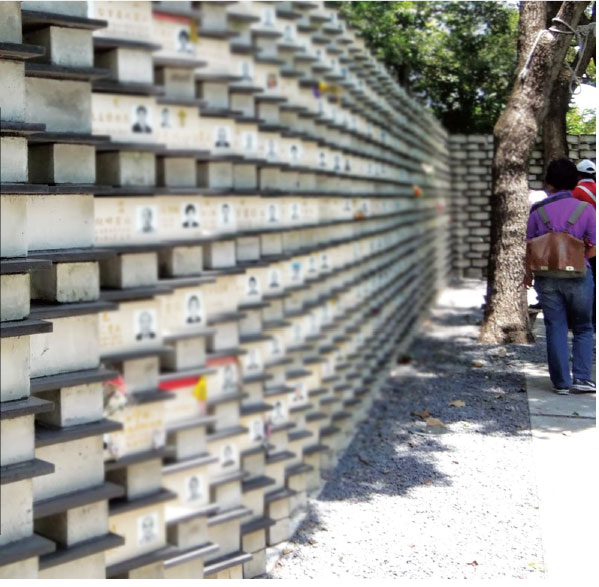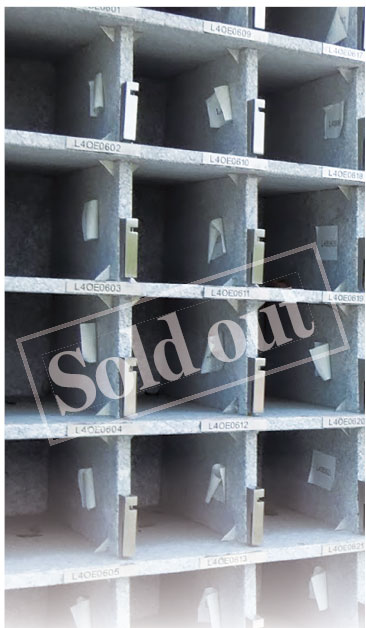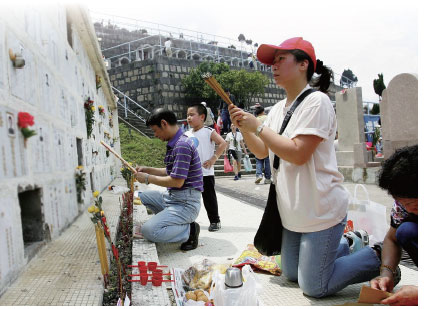Where the dead may not rest in peace
Updated: 2015-10-06 08:36
By Pearl Liu(HK Edition)
|
|||||||||
The city's columbaria facilities are near saturation point, but efforts to build more such keep getting thwarted by people who do not want the remains of the dead in their backyard. A report by Pearl Liu.
Wearing a small, white daisy on her black dress, Michele Ma mourned the death of her grandfather. What lay ahead for Ma, and tens of thousands of bereaved families, was a drawn-out, bureaucratic nightmare.
Cremation or burial in Hong Kong might take months longer than in most other places around the world. And there is little that can be done, but mourn and wait.
The entanglements lead some to opt for "green burial" - scattering the ashes in the sea or on public land. The idea is slowly gaining traction in the city.
In Hong Kong, one of the most densely-packed cities on earth, even the dead must wait in queues for a final resting place. If the situation isn't emended soon, there will be no permanent place for families to store the ashes of lost loved ones, much less to bury family members in a cemetery plot.
The funeral of Ma's grandfather, who died just recently, is not likely to take place in several months. In the Chinese mainland, funerals are usually observed in less than a week after death. In most places in Europe or North America, it takes only a few days. In Hong Kong, bureaucratic hassles, lack of facilities and demographic realities tend to get in the way.
Long-drawn process
First, the death must be reported to the Deaths Registry. The registry issues a certificate, granting permission to a hospital, home or other authority to release the body to a funeral home.
Next the time and date for cremation need to be registered. Facilities are normally booked a month to six weeks in advance. The body is refrigerated until the appointed time.
Following cremation, it takes several weeks before the ashes of the deceased are handed over to the family. Finding a suitable place to store the ashes could take over a month.
"We are trying to apply to a columbarium, but waiting lists at every public-operated columbarium are very long, while private ones are amazingly expensive," Ma complained as she chose an urn at a funeral parlor in Hung Hom, the hub of funeral services in the city.
"We may just put (the urn) at home first and hope we can find him an appropriate place to rest in peace soon," she said with a light sigh.
But "soon" is relative. Ma and her family expect to wait three years for a niche at one of the city's eight public columbaria. It is not unheard of for families to have to wait as long as five years.
"The biggest challenge is that there is not enough space," said Lam Wai-lung, a director at the Hong Kong Funeral Business Association. He estimates that there are between 80,000 and 100,000 urns holding cremated remains that are now waiting in storage at funeral homes or in people's homes across the city, until a permanent place becomes available.
"That is just for now. If the government cannot build more niches, the shortage will get worse," he said.
There are eight public columbarium facilities in Hong Kong, lined floor to ceiling with A4-size niches. The newest is the five-storey Wo Hop Shek Kiu Tau Road Columbarium with 43,710 niches, which opened in 2012. Last year 24,000 new spaces were offered, using a ballot system. All available spaces were filled in just a few days.
"That supply cannot even meet the demand of a single year's cremations," said Lam, who also operates a funeral goods and services business. He has been running a funeral parlor in Hung Hom for 24 years.
Last year 44,800 people died in Hong Kong, 3.4 percent more than a year earlier, according to the Hong Kong Census and Statistics Department, which expects the figure to rise in the coming decades until 2041, a year when deaths are expected to peak at an estimated 82,000. The projected increase in death rate is directly related to the city's aging population.
About 92 percent of the city's dead were cremated last year, up from 38 percent in 1975. This massive increase underlines the success of the city's funeral policy. Since the late 1970s, in order to alleviate the shortage of grave plots, Hong Kong started to ban construction of new permanent burial sites. Public cemeteries were ordered to exhume remains after six years, effectively recycling plots.
"Burials are more expensive, troublesome and require even longer waiting time and that is why more and more people choose cremation," Lam explained.
Resistance from neighbors
By 2016 there will be no space in either public or private columbaria for about half the people who die every year, according to government estimates. Efforts to build new facilities were resisted by people living in the neighborhood.
Since 2010 the government has identified 24 potential sites in 18 districts to build facilities that could boost the supply of niches by several hundred thousands by 2031. Every site proposed was resisted by the local population, citing smoke from burning incense offerings, air pollution, heavy traffic from visitors and, most importantly, the bad feng shui created by columbaria. Property prices in the vicinity are likely to suffer, opponents argue.
The effect on property prices is a serious concern. In Hung Hom a two-bedroom flat rents for just HK$9,000 per month because of its proximity to a columbarium. A similar flat in Sha Tin, four stops further away from Hong Kong's central business district, can fetch as much as HK$12,000 per month.
It took five years just to add an extension to the Diamond Hill columbarium, which has opened up niches for 1,540 more urns. Another project in Tuen Mun just got the green light from the Legislative Council (LegCo) in April and will be completed by the end of 2018. The rest are still on the table for debate.
"Everybody is against having cemeteries or columbaria in their neighborhood; but everyone needs these facilities," said a funeral service operator surnamed Lai. "Where should they place their relatives' or families' ashes?"
For wealthy families, a time-saving option is the private columbarium, many of which come with landscaped gardens and pools. A single niche can cost HK$200,000 to HK$300,000. The cheapest private facilities in remote locations can cost HK$50,000, as against the HK$3,000 that public facilities charge.
"Even when they can afford this, some people still have concerns, such as whether they might later find out that the facility was illegal," said Yvonne Lo, senior service manager at St. James' Settlement, which provides funeral consultation and services for elderly residents who have lived on their own for more than 10 years. "If that happens, then the big bucks they paid were all in vain."
At the moment, there are no standard regulations for columbaria. A bill to license private facilities was proposed last year but it's still under discussion by LegCo.
The green burial option
Taking all this into consideration, the popularity of green funerals is growing, the key attraction being that it may be accomplished quickly.
"The burial ceremony can be held a month after the ashes are collected from the crematorium," Lo explained, adding that half of the 1,000 or so cases her organization is handling are likely to go for a green burial.
"They are more open to the idea because on the one hand these services carried out by the government are good and, on the other these people who are on their own believe there is no need to set up a particular niche for relatives to visit."
Still, the other half insists on a traditional niche, believing that if ashes are scattered the soul may remain on earth, waiting. According to Lo, there are instances of people dead for over four years not having found a permanent place to store their ashes yet.
While the government is making continual efforts to promote green burials, it takes time to bring about the necessary change of mindset. Meanwhile, keeping ashes in niches will remain the mainstream mode for some years to come, the Food and Health Bureau noted.
"The dead, in Chinese culture, are to be respected. It is not good to keep them waiting for a place to rest," said Lai, the funeral service operator. "We, the living, should not be selfish and block the expansion of funeral-related infrastructures."
Michele Ma's grandfather was, finally, cremated at the end of August, three weeks after his death. Ma in fact is thankful that it did not take as long as she had expected. But it is only a beginning and it has led her to think about her own last rites.
"I might take sea burial, but a niche is better as my family can come and visit me and chat with me. It is like I am still with them," said Ma, who is in her 30s. "I can only cross my fingers and hope by that time, the government has already set up enough places for people to rest in peace not too long after they are dead."




(HK Edition 10/06/2015 page7)